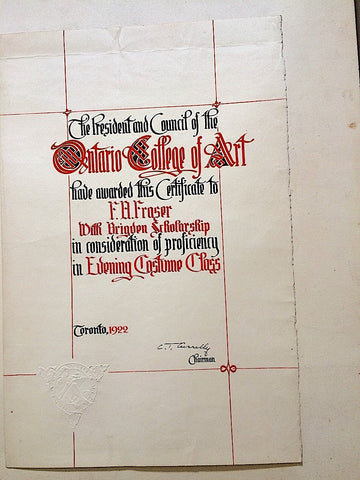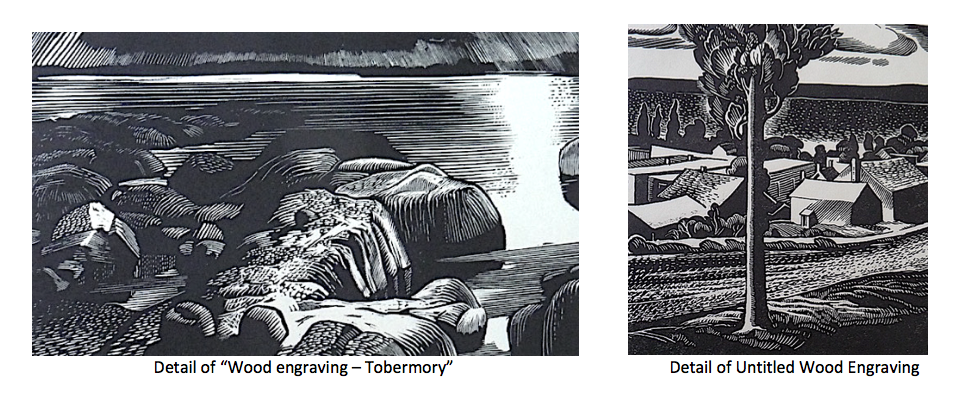Frederick Alexander Fraser Canadian Watercolourist & Master Engraver November 18 2019
Frederick Alexander Fraser (1897-1975), the youngest of the twelve children of Scottish immigrant parents, was born and lived in Toronto. His early life was difficult as his father, Simon Fraser, lost his bakery and his sulky racing stallion, Abdulla, on a single horse race and then, abandoned his family following this loss. On his 14th birthday, June 17, Fred left school to go to work. He was in Grade 7.
Fraser’s first job was in the commercial printing industry at Photo Engravers where he polished stones used in the printing process. His creative talent and developing interest in art allowed him to move to typesetting and then into the art department.

Frederick Alexander Fraser in 1916, age 29.
At age 21, Fraser began attending night classes at the Ontario College of Art (OCA) and studied regularly from 1918 to 1929. At OCA, he studied under some of Canada’s best instructors and recognized landscape artists including George Reid, Charles MacDonald Manly, John William (J.W.) Beatty, Arthur Lismer and James Edward Hervey (J.E.H.) MacDonald. It didn’t take long for Fraser to find his niche and for others to recognize his artistic ability. Fraser won Honourable Mentions in the Evening Costume Class in 1920 and 1921, and was the recipient of the Brigden Scholarship in 1922, awarded to a student showing exceptional ability.

Certificate for Brigden Scholarship, Proficiency in Evening Costume Class,
Ontario College of Art, 1922.
Fraser earned a Temporary Vocational Teaching Certificate in 1932 from the Ontario College for Technical Teachers which had been established in Hamilton in 1925. By the time his Vocational Teaching Certificate became permanent in 1935, Fred had married Hazel, nee Finch (1903-1997), and had two children, Barbara and Donal.
Hired as an art instructor at Western Technical-Commercial School, Fraser taught still life, life drawing, watercolour and lettering from 1932 to 1963 alongside Lawrence Arthur Colley (L.A.C.) Panton. To be close to his teaching position, Fraser moved to Durie Street and then to Runnymede Road in Toronto's Bloor West Village. In 1937, Fraser purchased his first car, a new Plymouth. The family, now including two more children, Valerie and Roderick, spent summers in Muskoka. First, they camped on the shores of Gull Lake, Gravenhurst, then they built a cottage on Fox Lake, near Huntsville. Oils and watercolours of the Muskoka region make up some of Fraser’s body of work.
One of Fraser's most well-known students was Harold Barling Town, a founding member of the Canadian Painters Eleven group of abstract artists. Town enrolled in the art program at Western Technical in 1938 at age 14. From the time he started at Western Technical, Town referred to himself as an artist.[1] Fraser was a known disciplinarian and Town was a known troublemaker. Fraser always said that he was very proud of Town’s accomplishments as an artist. As Fraser worked and taught in multiple mediums perhaps his influence on Town was to help him defy stylistic trademarks and to create in all mediums. Fraser and Town both excelled in painting and printmaking and both artists appreciated craftsmanship. Fraser was conventional for his time, yet Town was anything but. Town went on to create some of Canada’s most collected works, and Fraser’s are now being rediscovered.
Another of Fraser’s Western Technical students (1948-1952) was Vancouver Island-based woodblock artist Graham A. Scholes who remembered Fraser well. Scholes wrote in 2019 that Fraser had a positive influence on him as a student: “He was a task master and was most instrumental in developing my ability to paint in watercolours. I realize now, the influence he had on me in my move to printmaking.”
Fraser joined the various Canadian art associations for connections, recognition and exhibition opportunities. From 1926 to 1956, he exhibited with the Ontario Society of Artists, Royal Canadian Academy of Arts, Canadian Society of Painters in Water Colour, Canadian National Exhibition, Canadian Society of Graphic Art and the Art Association of Montreal. Like his colleagues including L.A.C. Panton and J. W. Beatty, he was not only a member but also became part of the Board of Directors. He was Treasurer for the Canadian Society of Graphic Art from 1945 to 1954.
Fraser was an artist who contributed to the distinctive tradition of Canadian painting. He knew the work of earlier Canadian painters and his peers including Group of Seven members along with Quebec-based watercolourists and wood engravers such as Edwin Holgate and Goodridge Roberts; his work was exhibited with theirs.

Fraser’s documenting of industrialization started early in the 1920s with the docks and street scenes of Montreal and Toronto. Prior to and during WWII, he captured the workers at the lumber mill, road building and, one of the family’s favourites, at Ollie Elm’s tire shop on Elm Street in Toronto.

In addition to watercolour painting and life drawing, Fraser taught lettering and printing. An understanding of printing techniques and a skilled command of a graver allowed him to capture light and mood with precise detail, particularly in his wood engravings, the benchmark in fine relief printing.

In the company of A.J. Casson, A.Y. Jackson and W.J. Phillips, Fraser produced relief print Christmas cards of his own graphics from elaborate woodcut or lino blocks using his own printing press.

Fred supported the local community by creating posters for Runnymede United Church and for William H. Temple, also known as “Temperance Bill”, who was a member of the Ontario parliament and a crusader for keeping West Toronto alcohol free.
After he retired from teaching in 1963, Fraser began creating designs for medallions and entered coin design competitions across the country. His work was noticed by the Wellings Manufacturing Co. Ltd. of Toronto where in 1964, he created the Stratford City Council’s memorial medallion to commemorate Shakespeare’s 400th birthday that was issued in bronze, silver, gold and platinum. He then created a series of the fathers of Confederation for Canada’s Centennial in 1967.
Fraser passed away on February 16, 1975 at home.
In 1991, his family donated some of his teaching books on illustration, composition and design to the Art Gallery of Ontario’s library.
Frederick Alexander Fraser’s artwork is held in both private and public collections.
[1] Iris Nowell in P11, Painters Eleven: The Wild Ones of Canadian Art, page 159, Douglas & McIntyre, 2011.
Museum Collections:
The Robert McLaughlin Gallery, Oshawa, ON (Gifts from Charles Goldhamer in 1985 and Joan Murray, 3 paintings, in 1989)
Exhibitions:
1956 Ontario Society of Artists
1945 Canadian Society of Graphic Art
1944 Canadian Society of Graphic Art
1943 Ontario Society of Artists, Canadian Society of Graphic Art
1942 Ontario Society of Artists, Canadian Society of Painters in Water Colour
1939 Canadian Society of Painters in Water Colour
1938 Canadian Society of Painters in Water Colour
1937 Canadian Society of Graphic Art, Canadian Society of Painters in Water Colour
1936 Canadian National Exhibition, Canadian Society of Painters in Water Colour
1935 Canadian National Exhibition, Canadian Society of Painters in Water Colour
1934 Ontario Society of Artists, Canadian Society of Painters in Water Colour, Canadian National Exhibition
1933 Canadian Society of Painters in Water Colour
1932 Ontario Society of Artists
1931 Canadian Society of Graphic Art, Canadian Society of Painters in Water Colour (CSPWC), Canadian National Exhibition
1930 Ontario Society of Artists, Royal Canadian Academy of Arts, Canadian National Exhibition, Art Association of Montreal
1929 Ontario Society of Artists, Canadian Society of Graphic Art, Canadian National Exhibition, Art Association of Montreal
1928 Ontario Society of Artists (OSA), Canadian Society of Graphic Art (CSGA), Art Association of Montreal, Canadian National Exhibition
1927 Art Association of Montreal
1926 Ontario Society of Artists (OSA), Canadian Society of Graphic Art (CSGA), Royal Canadian Academy of Arts (RCA), Canadian National Exhibition (CNE), Art Association of Montreal (now Montreal Museum of Fine Arts)
Sources:
Fulford, Robert. (1969). Harold Town Drawings. McClelland and Stewart Ltd., Toronto.
Government of Canada, Artists in Canada retrieved online at https://app.pch.gc.ca/application/aac-aic/artiste_detailler_basartist_detail_bas.app?rID=5791&fID=2&lang=en&qlang=en&pID=1&an=frederick+fraser&ps=50&sort=AM_ASC
Ontario Library Review. (1949). Who’s Who in Ontario Art. The King’s Most Excellent Majesty Press.
McMann, Evelyn de R. (?) Biographical Index of Artists in Canada. Page 77. University of Toronto Press.
McMann, Evelyn de R. (?) Montreal Museum of Fine Arts, formerly Art Association of Montreal, Spring Exhibitions 1880-1970. Page 134. University of Toronto Press.
McMann, Evelyn de R. (?) Royal Canadian Academy of Arts/Academie royale des arts du Canada, Exhibitions and Members 1880-1979. Page 136-137. University of Toronto Press.
Nowell, Iris. (2011). P11, Painters Eleven: The Wild Ones of Canadian Art, page 159, Douglas & McIntyre.
Saur, K. G.. (2005). Allgemeines Kunstler-Lexikon Die Bildenden Kunstler aller Zeiten und Volker, Band 44 Francoini-Freyenmuth. Page 195. Munich, Leipzig.
The Robert McLaughlin Gallery, Permanent Collection retrieved online at https://rmg.minisisinc.com/m3online/scripts/mwimain.dll/149/1/0?SEARCH&SHOWSINGLE=Y&ERRMSG=[M3ONLINE]error.html
